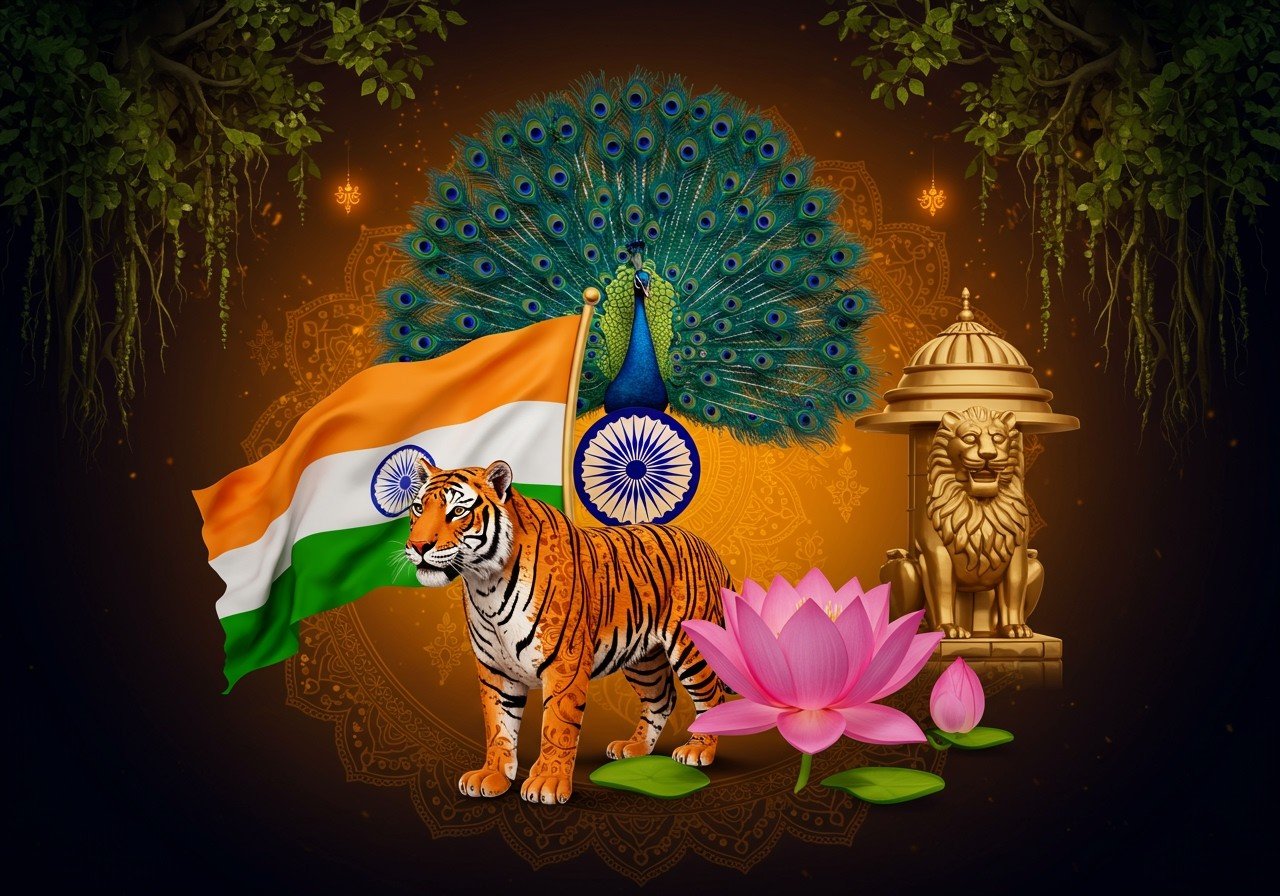
India, a land of rich cultural heritage and diversity, is represented by various national symbols and figures. These emblems reflect its history, values, and traditions, instilling pride among Indians and representing the country globally. This guide explores these essential symbols.
The National Flag
The Tricolor, or ‘Tiranga,’ embodies India’s freedom struggle and sovereignty. It features three horizontal stripes: saffron for courage and sacrifice, white for truth and peace, and green for faith and chivalry. The navy blue Ashoka Chakra, a 24-spoke wheel at the center, symbolizes the eternal wheel of law. Adopted on July 22, 1947, the flag was designed by Pingali Venkayya.
The National Emblem
The Lion Capital of Ashoka at Sarnath serves as India’s national emblem. Four Asiatic lions stand back-to-back, representing power, courage, pride, and confidence. It also includes the Ashoka Chakra, a horse, and a bull. The motto ‘Satyameva Jayate’ (Truth Alone Triumphs), from the Mundaka Upanishad, is inscribed below. It was adopted on January 26, 1950.
The National Anthem
Composed by Rabindranath Tagore, ‘Jana Gana Mana’ is India’s national anthem. Adopted on January 24, 1950, this Bengali song reflects India’s unity and diversity, invoking the collective spirit and pride of its citizens. It’s played during national occasions and ceremonies.
The National Song
‘Vande Mataram,’ composed by Bankim Chandra Chattopadhyay, is India’s national song. This Sanskrit composition praises the motherland and inspired the Indian independence movement. Its first two verses were adopted on January 24, 1950.
National Symbols: Animal, Bird, Flower, and Tree
- Royal Bengal Tiger: The national animal, symbolizing strength, power, and grace. Its presence reflects India’s commitment to wildlife conservation efforts.
Poojn.in offers beautiful brass statues of powerful animals like tigers, showcasing India’s rich artistic traditions. - Indian Peafowl (Peacock): The national bird, representing beauty and grace. Its vibrant plumage is often depicted in traditional Indian art and culture. Poojn.in provides vibrant alta dye, reminiscent of a peacock’s feathers, perfect for traditional ceremonies and celebrations.
- Lotus: The national flower, symbolizing purity and enlightenment. It plays a significant role in Hindu mythology and spirituality. You can find Lotus-themed items for your spiritual practices at Poojn.in.
- Banyan Tree: The national tree, symbolizing longevity and resilience. Its vast, spreading branches represent India’s enduring strength and interconnectedness. Poojn.in offers meditation asanas perfect for connecting with nature, much like the banyan tree’s grounded presence.
Key Figures and Governance
India’s President, currently Droupadi Murmu (as of 2024), is the ceremonial head of state. The Prime Minister, currently Narendra Modi (as of 2024), is the executive head, responsible for policy decisions. India’s federal parliamentary democratic republic structure vests significant power in these roles. For more information on Indian Governance, visit this insightful article.
Other National Symbols
The Government of India has designated 17 official national symbols as of 2024. These symbols include the tricolour flag, the Indian Rupee (INR, ₹), the Ashoka Chakra emblem, the national anthem (‘Jana Gana Mana’), the national song (‘Vande Mataram’), the national animal (Royal Bengal Tiger), the national bird (Indian Peafowl), the national flower (Lotus), the national tree (Banyan Tree), and others. These symbols play a role in fostering unity and national pride.
India also recognizes a national calendar (Saka Era, adopted March 22, 1957), and considers Field Hockey its national sport. The country’s vibrant festivals, like Diwali, Holi, Eid, and Christmas, promote unity and cultural harmony. You can find supplies for these festivals at Poojn.in.
Exploring Andhra Pradesh
For those interested in learning more about Indian states and their unique aspects, explore our articles on Andhra Pradesh:
- Andhra Pradesh: A Journey Through Time, History, and Formation
- Andhra Pradesh Cuisine: A Culinary Journey
- Andhra Pradesh Location, Map & Key Cities: A Complete Guide
- Andhra Pradesh Wildlife & National Parks: A Guide to Natural Beauty
- Andhra Pradesh State Symbols: Exploring Regional Identity
Conclusion
India’s national symbols and figures are more than just representations; they embody the country’s heritage, diversity, and values. They inspire and unite, fostering national pride and identity. From the Tricolor to the Lion Capital, the Lotus to the national anthem and song, these symbols hold a special place in every Indian’s heart, reminding us of our shared history, achievements, and future as one nation.
You can find a variety of products related to India’s rich cultural heritage at Poojn.in. From incense and diyas to puja items and home decor, Poojn.in offers a wide selection to help you celebrate and honor India’s traditions.


